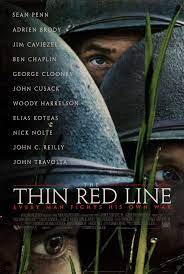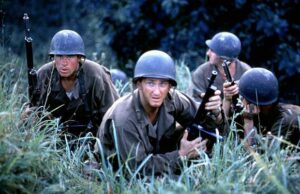“The Thin Red Line – Terrence Malick’s War Allegory [Film Analysis]

Title: “The Thin Red Line”
Release Date: 1998
Director: Terrence Malick
Cast: Sean Penn, Adrien Brody, Jim Caviezel, Ben Chaplin, John Cusack, Woody Harrelson, Elias Koteas, George Clooney, Nick Nolty
“(…) there is only a thin red line between the sain and the mad” – this saying James Jones made the motto of his famous novel. Terrence Malick worked on the film adaptation of this book for as long as nine years. In the end, he created a philosophical parable of war that polemicized with mainstream cinema glorifying national American values. War in Malick’s case is a total absurdity forever imprinted on its victims and participants.
“The Thin Red Line” – a few words about the novel
“The Thin Red Line” was published in 1962. It was the second part of the war trilogy by James Jones, who fought on the front lines of World War II and took part in the American operation on the Japanese-controlled island of Guadalcanal, part of the Solomon Islands archipelago in the Pacific. The novel depicts just this episode of the global armed conflict, while the action of the first link in the series, “From Here to Eternity” (1951), takes place just before the Japanese attack on Pearl Harbor (it ends with an air raid), while the third book, “Whistle” (1978), depicts the post-war fate of the soldiers.
The different parts are linked not only by the war plot, but also by the protagonist. In “From Here to Eternity” the leading character is Robert E. Lee Prewitt, in “The Thin Red Line” he returns as Witt, while in “Whistle” Bobby Prell appears. The protagonist, who can in turn be regarded as the author’s porte-parole, is Five, a war-terrified soldier indulging in constant dreams of returning home, who is seriously wounded on the battlefield and eventually sails away with other veterans to the US.

“The Thin Red Line” – Terrence Malick reads James Jones
Terrence Malick’s 1998 Golden Bear-winning film largely captures the spirit of Jones’ prose, especially in the essential message, which boils down to depicting the absurdity of war and the degenerating mechanisms of the army. At the same time, however, the director makes a number of significant changes that highlight primarily the philosophical rather than realistic dimension of the story. Witt, who in the book “The Thin Red Line” is a marginalized figure, in Malick’s work becomes almost a leading character, although it should be noted that we are dealing here with the accounts of several soldiers, none of whom can be considered the main protagonist.
Private Robert Witt (played by Jim Caviezel) is a born idealist, assigned to a penal company for insubordination, with which he arrives on the island of Guadalcanal in 1942. The man is to serve as a stretcher bearer pulling the wounded from the battlefield. Paradoxically, the soldier closest to him is Sergeant Edward Welsh (Sean Penn), who adheres to a philosophy of life completely at odds with his own. Welsh believes that the mortal world is the only reality that exists, and what’s more, this world is “bombed to pieces as fast as you can.”
Private Jack Bell (Ben Chaplin), on the other hand, is a military officer demoted from the rank of officer, who has moved away from the service because of his longing for his beloved wife. The soldier is constantly thinking about the woman, and love is the only force keeping him alive in the hell of war. Corporal Geoffrey Five (Adrien Brody) is the most timorous of all soldiers, hoping to return home quickly. The operation to attack the island is led by Colonel Gordon Tall (Nick Nolty), a senior military officer who has so far failed to earn a serious promotion and believes that “the war is the best thing that happened to him.” Possessed by visions of personal gain, he disregards the mass deaths of his soldiers and pushes on to conquer more hills in the archipelago at all costs. However, Tall encounters resistance from Captain James Staros (Elias Koteas), who treats his men in a fatherly manner and cannot accept their senseless deaths.

“The Thin Red Line” and Malick’s philosophical narrative
Each of the changes Malick has made to the original is aimed at constructing a parabola, that is, a metaphorical story that refers to a higher floor of meaning through the realities depicted. And so the first significant shift is made at the level of narration, which turns from third-person narration in the movie into a sum of stories told in the first person. The introduction of the narrator’s voice is a very characteristic procedure for this director’s cinema. There are several “storytellers” in “The Thin Red Line”, but at the same time it is difficult for the viewer to recognize which character is currently speaking. This creates a polyphonic vision of the world that makes it impossible to identify with one point of view.
What’s more, the characters’ internal monologues don’t actually tell anything, so they have no narrative character. They are philosophical reflections on the war experience. It is clearly indicated that the world here consists, so to speak, of two layers: one is the real events, while the second floor is the processing of the same events in the minds of the characters. This second tier seems to exist outside of time and space. The reflections of the characters, as it were, suspend the action of the film and transport it to another dimension, which is emphasized by the music and the unhurried frames of landscapes.
It is significant, however, that this polyphonic narrative has a kind of coherence, already suggested by the aforementioned difficulty in distinguishing between individual voices. Moreover, the reflections of the characters do not contradict each other, but rather complement each other, building a relatively unified philosophy of opposition to the madness of war. In this way, the absurd horror of war becomes a universal experience, which is a fundamental characteristic of parabola.

“The Thin Red Line” – the allegorical nature of the depicted world
The allegorical nature of Malick’s “The Thin Red Line” is also evident within the depicted world. Here we have a clear contrast between the delightful exotic nature and the repulsive actions of man. It is significant that in this case, too, the director portrayed the space differently than in the novel. In Jones’ text, nature becomes a projection of the inner experiences of the characters: the more bloody the experience, the more hostile the seemingly beautiful island demonstrates its face: torrential rains fall, soldiers get bogged down in the muddy jungle and fight tropical diseases.
In Malick’s movie, on the other hand, the opposite is true – nature remains undefiledly beautiful and perfect, which creates a distinct cognitive dissonance in the viewer. The very beginning of the invasion of the island has the character of a peculiar absurdity. As the soldiers make their way through the tall scrub, they are indifferently passed by strolling natives, while wild birds and monkeys seem to watch the military’s actions with astonishment. The armed army is an intruder in this reality. The intrusion of war into an exotic landscape evokes associations with the biblical original sin and has analogous consequences: death and knowledge of the nature of evil. On the other hand, the invulnerability of nature to human actions sets some horizon for the meaning of the world’s existence – despite the presence of crime.
Witt – the allegorical hero of “The Thin Red Line”
On the other hand, the parabolic senses of Malick’s movie are particularly focused on the character of Witt. An idealist filled with faith in the existence of another dimension of the world, devoid of fear of death, empathetic, providing sacrificial help to the wounded, he is, as it were, a being from another world. Magdalena Bartczak sees him as an incarnation of the Angel of Death hovering over the battlefield or Christ sacrificing himself for humanity. The latter interpretation is prompted especially by the scene of the hero’s death, who consciously and heroically gives up his life to save his fellow soldiers.

Nevertheless, the philosophical dimension is also carried by other characters of the movie “The Thin Red Line” and their fates. Jack Bell, obsessively longing for his wife, and perhaps subconsciously fearing her betrayal, eventually receives a letter in which his spouse asks him for a divorce and permission to marry another. Romantic love as a metaphysical force capable of surviving all obstacles, which is one of the myths of our culture, is therefore subjected here to a brutal unmasking. Another character: captain Staros is stripped of his command by the ruthless careerist Talla and sent back to his country in disgrace. His story therefore exposes the unjust mechanisms of promotion in the army and the awarding of combat decorations, but also reflects on similar laws governing all areas of society.
The world behind the thin red line
Malick’s consistently constructed allegory is a polemic against mainstream war cinema, which glorifies valor, honor and bravery. The parabola serves to show what lies beyond the titular “thin red line.” It is crossed by all the characters directly experiencing the war. The physical and omnipresent proximity of death – inflicted and observed in detail – changes soldiers forever. Such a cruel experience, as it were, suspends them in the indefinite space between life and death, and once they have crossed this line, they can never again return to their lost paradise. Just as the first people in the biblical story ate the fruit from the tree of the knowledge of good and evil, and came to know that they were naked, so the characters in the film experience a metamorphosis of their perception of the world.
This is most vividly seen in the story of Witt, who after the battle visits the island where he lived among members of a savage tribe before the war. What he previously perceived as unblemished perfection suddenly begins to reveal cracks and fissures. The hero notices that the men of the tribe quarrel and jerk each other around, the delicate skin of a child is bitten by bloodthirsty insects, and there are human skulls on the sand and in the houses. “Et in Arcadia Ego” – “And here I am in Arcadia” – the words of death come to mind, as the figures immortalized in Nicolas Poussin’s famous painting discover with horror.
The final scene of “The Thin Red Line”, however, breathes hope – on the sand of an island stained with human blood sprouts a tiny plant, a symbol of the world’s reason for existence and a tentative harbinger of its rebirth.
Literature:
M. Bartczak, Ciche światło na wojennym froncie. Cienka czerwona linia Terrnece’a Malicka, [w:] Adaptacje literatury amerykańskiej, pod red. R. Syski, Kraków 2011.
